Apr 19, 2024
Apr 19, 2024
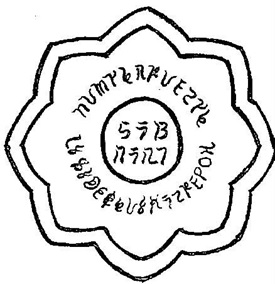 Housed at the Imperial House’s Shinto shrine of Ise Jingu is the Mirror of Yata. This mirror is considered a gift to Japan from the solar goddess, Amaterasu Omikami. The emperors believed so much in the presence of Amaterasu in the mirror that they assigned their own daughter to minister as a priestess over the shrine together with a large royal entourage.
Housed at the Imperial House’s Shinto shrine of Ise Jingu is the Mirror of Yata. This mirror is considered a gift to Japan from the solar goddess, Amaterasu Omikami. The emperors believed so much in the presence of Amaterasu in the mirror that they assigned their own daughter to minister as a priestess over the shrine together with a large royal entourage.
In the legend of Amaterasu, goddess of the sun, she and her own group of maidens reigned over a beautiful heavenly plain. They would tend the sacred rice fields, weave, dance and make contests. Susanowo, Amaterasu’s brother, challenged her to a contest to see who could produce more gods. Amaterasu took Susanowo’s sword and made three gods. Susanowo took Amaterasu’s jewel necklace and produced five goddesses. Amaterasu claimed victory since it was the female gods belonged to her. All was peaceful until her brother, Susanowo, desecrated the heavenly rice fields. Even worse, he butchered the heavenly horse and threw its skin into the room of Amaterasu, where she and her heavenly maidens were weaving.
Though Susanowo was banished for his crime, Amaterasu hid herself in a cave, causing darkness over the heavenly plain. All the heavens and earth gathered outside the cave to draw out the sun goddess and restore light to the world. Nothing would bring her out. So they performed a dance and placed a mirror in front of the cave entrance. Amaterasu peered out in curiosity at the festive sounds of laughter. There she saw herself in the mirror and was drawn out by her own beauty.
There was a great celebration as the entire universe was lit up once again. Even Susanowo repented for his irreverence and offered his own reconciliation gift. He killed the eight-headed dragon, Yamata no Orochi, and gave the tail which became a sword to Amaterasu.
Having restored the universe, Amatersu turned to her son, Ame no Oshidomimi to offer gifts to the human emperor in order to maintain order until she return. Her son was not able to overcome the chaos of the earth. So she turned to her grandson, Ninigi no Mikoto. He offered the emperor the jewel necklace of Amaterasu, the sword of Susanowo and the mirror of Yata that brought the light out of the cave. The emperor of Japan placed these three gifts in the Shrine of Ise; the people learned the arts of agriculture, weaving and dance; the country was united under the Shinto faith; and the world was restored to order until Amaterasu returns. The Shinto believe one day this Princess of the Sun will return through the mirror.
There is a clue to the return of this Maiden of Heavenly Enlightenment written on the back of this mirror. This writing was recorded by, a Shinto believer, who was given special permission by the Ise priest after World War II. The letters Yutaro copied are present in the center of the diagram above.
Yutaro was inspired to write the text from the back of the mirror upon hearing rumors that the Hebrew name of God was written on the back. Yutaro’s daughter, together with the Shinsei Ryujinkai Shinto believers, felt called after much prayer to reveal the letters to the Emperor’s family and later to the public in the book of Shinto researcher Wadoh Kohsaka.
← These 4 letters represent the Hebrew name of God on the Mirror of Yata.
If this inscription is genuine, it represents a monumental discovery regarding the extent of diaspora for earlier Jewish exiles. Further study of the inscription on the mirror is the primary focus of this research toward verifying its authenticity or exposing it as a hoax. Since some of the letters appear Hebrew and others early Japanese, there has been confusion as to how to interpret the text. Yet, notice the similarity between the Hebrew and early Japanese scripts below:
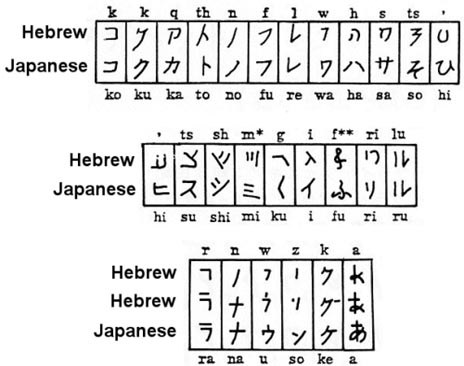
Japanese Script on the Mirror of Yata
There are relatively few true Japanese signs on the back of the Mirror of Yata. Of the 37 signs, only 11 appear to be from the early Japanese script; 6 if repeats are excluded. Of these 6 signs, four are not only syllables, but actual numbers as well. How these numbers and syllables add meaning to the inscription on the mirror is described below.
There are four early Japanese number signs on the Mirror of Yata appearing among the lower 18 signs as follows:
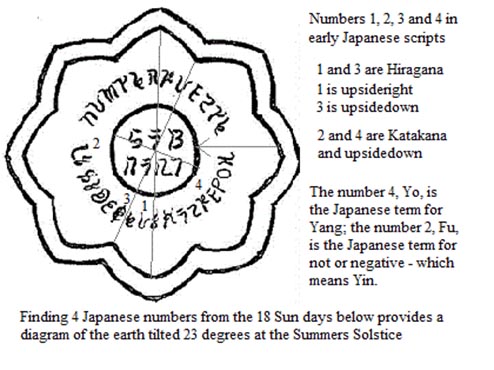
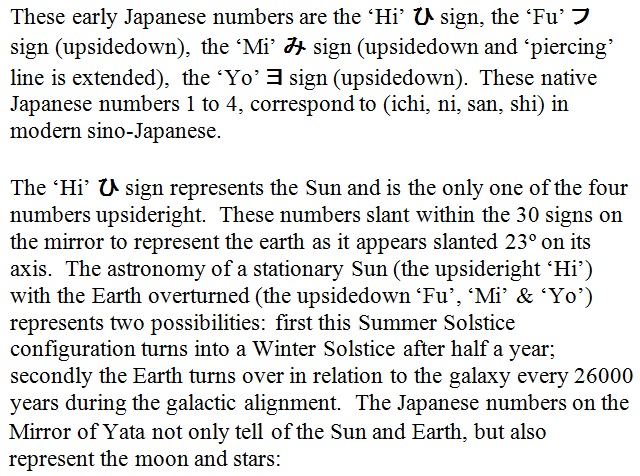
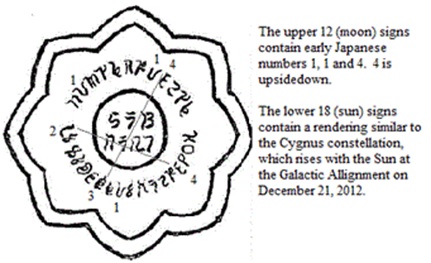
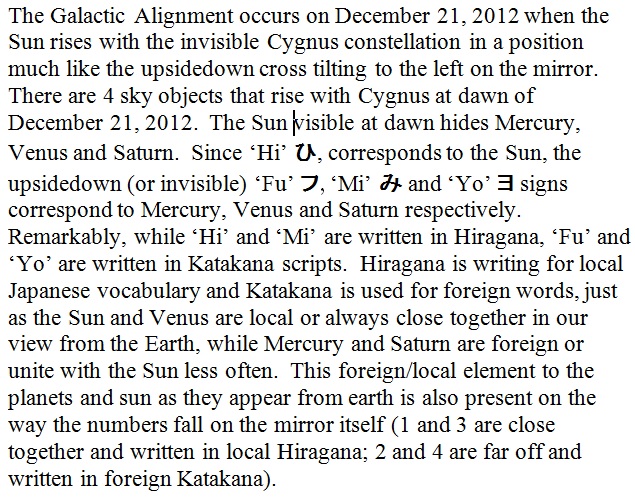
Regarding the numbers 1, 1 & 4 among the 12 moon signs in the upper portion of the Mirror of Yata, it is exactly 114 days to April 14, 2013 from December 21, 2012. We know that December 21, 2012 is an astronomical day that occurs once every 26000 years (the Galactic Alignment), but what is the big deal of April 14, 2013? It is a day when Mars, Venus and the Sun are almost conjunct in Pisces. In fact only 7 days earlier, Mars and Venus aligned; and only 3 days later Mars disappears behind the Sun. In between these unusual events the Moon and Jupiter are conjunct (in Taurus) exactly on April 14, 2013 and the moon is 4 days old.
Not only are the Japanese number signs significant in pointing to the seasons and the sky, the amount of signs on each section of the mirror is also significant. Consider the diagram below:
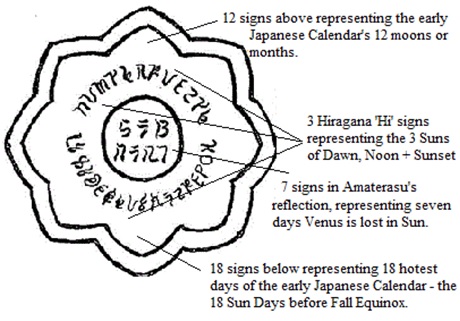
Three early Japanese syllables are also present on the Mirror of Yata. These are the ‘ra’, ‘wa’ and ‘hi’ syllables. Below is a brief description of these syllables, their Chinese origins and how they compare with the early Hebrew Script.
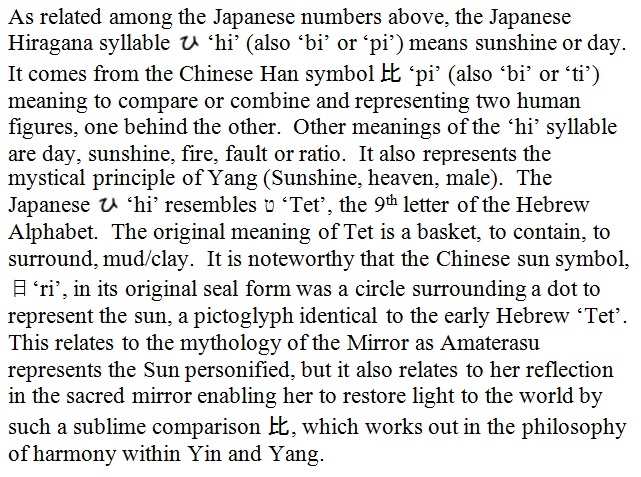
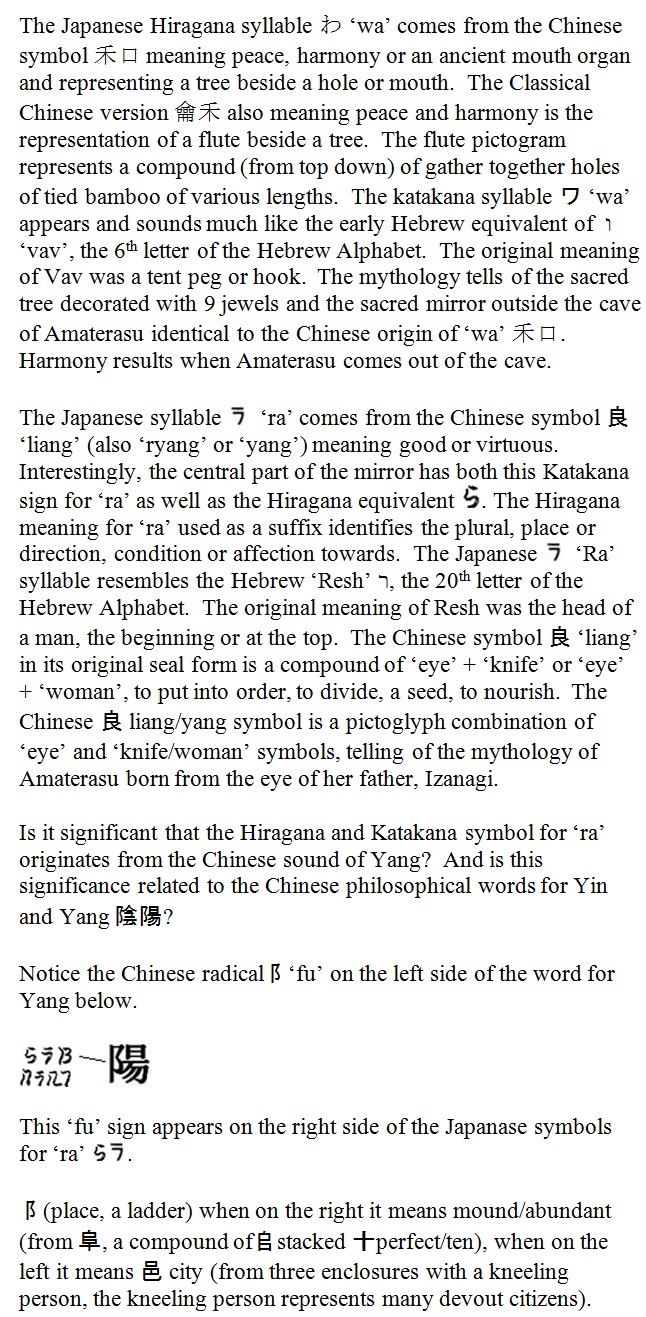
In the diagram below, the Chinese Yang symbols for mound, sun and rays of the sun are pointed out on out. Also notice the alternative meaning of the ‘fu’ sign used on the central portion of the Mirror of Yata. Instead of mound, city is chosen since it appears on the right side of the Japanese ‘ra’ signs. Virtuous City of Ra, deity of the Sun, draws ancient Egypt into this mystical dialogue of sages on the Mirror of Yata.
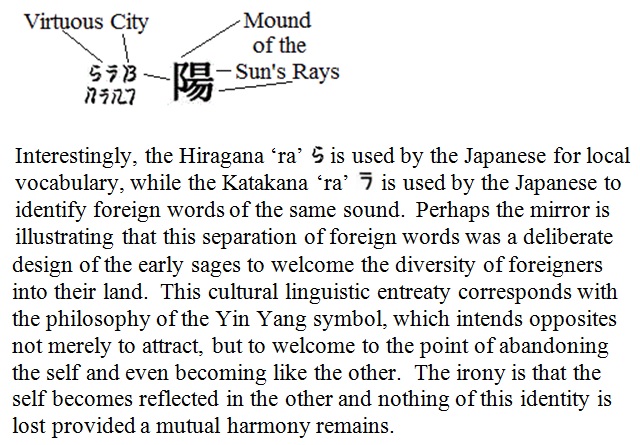
To honor these Jewish exiles into the mythical story of Japan, the Mirror of Yata’s Virtuous City can freely expand into the Virtuous City of G-D (Hebrew), namely Jerusalem. The Hebrew sages include a word play on the City of the Sun (or Ra) to place their hearts not only in Jerusalem, but also in this land of exile where the nearest Hill awaits the Dawn of Amaterasu.
The Shinto sages welcomed the Jewish sages much like the Chinese wisdom keepers welcomed the Shinto. That is the Chinese Yin and Yang symbols can be understood directly from the Chinese pictoglyphs to mean what they teach to the Chinese. However, the Chinese loaned syllables to the Japanese that offer an expanded Japanese meaning to the Yin Yang symbols.
Consider the Yin Yang symbols as they translate from the Chinese writing. As described above, the Yang symbol means Hill of the Sun’s Rays. Below is a breakdown of these Chinese meanings:
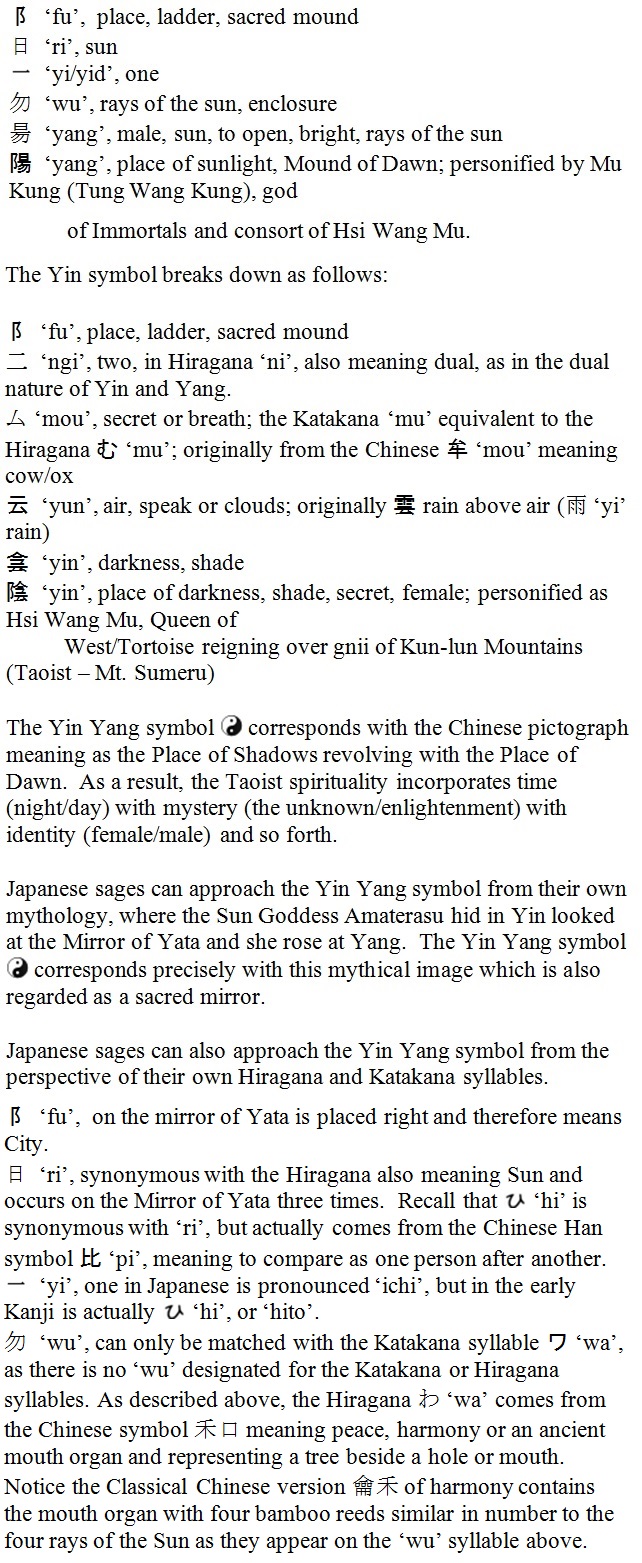
Therefore, the Japanese Hiragana and other symbols on the Mirror of Yata expand the Chinese Yang symbol from a Japanese mythological perspective. The Hiragana and Mirror define Yang as the City of the Sun reflecting the One who brings peace, like the sound of pipe and laughter that beckoned Amaterasu to gaze out of the cave at the mirror hanging on the tree of life.
The Mirror of Yata inscription was not only designed to reflect Hebrew characters, but also the Chinese Yang symbol through early Japanese and Hebrew scripts. The definitive proof consists in the following: using the diagram below, ‘a’ corresponds to the Sun ‘ri’ or ‘ra’; ‘b’ corresponds to the place ‘hill’ or ‘city’; and ‘c’ corresponds to the four rays of dawn or four marks of the Hebrew Tetragrammaton (the name of G-D).
Having the Mirror of Yata inscription contain the Hebrew name of G-D and the Yang symbol is significant in itself. Yet, how does the Katakana and Hiragana Japanese scripts of the 9th Century c.e. appear on a mirror from the 3nd or 4rd Century c.e.? There are two possibilities: first that the mirror’s inscription was not genuine to the original mirror of Amaterasu and was carved around or after the 9th Century; and second that the Mirror inscription is genuine by reason that the Katakana and Hiragana scripts were designed in part using this mirror’s inscription.. Either way, there was a Shinto and Hebrew influence in the carving of this inscription.
Though the script does have a fraction of its symbols in early Japanese, Chinese and Hebrew, the majority of the symbols still remain a mystery. There must be another script present on the mirror. Legend has it that the Mirror of Yata was a gift to the Emperor of Japan by the solar goddess, Amaterasu and that this exchange occurred around the 3rd or 4th Century c.e.. The above confirmation of the presence of the Hebrew name of G-d and the Chinese Yang symbol is also telling of the influence of ancient Hebrews from a diaspora of mirror’s antiquity. These Hebrews developed or joined a community of sages that included the Shinto and Taoist influence also on the mirror. Coming to Japan, the Hebrews passed through China and must have also been in contact with ancient India on their travels from the Middle-East. Is there evidence of the ancient Brahmi occurring on the Mirror of Yata?
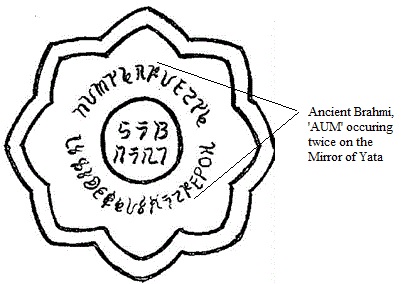
At first glance the most striking Brahmi character is the ancient Aum symbol pointed out on the mirror above. Considering the regions between Israel and Japan and identical ‘Aum’ sign occurring twice on the mirror, the ancient Brahmi is a candidate for more complete decipherment of the mirror. For example, ancient Brahmi match close to 75% of the letters (27/37) almost exactly, where even the early Japanese or Hebrew scarcely matched closer to 25%. Consider the chart below which names the Brahmi and Hebrew found on the mirror.
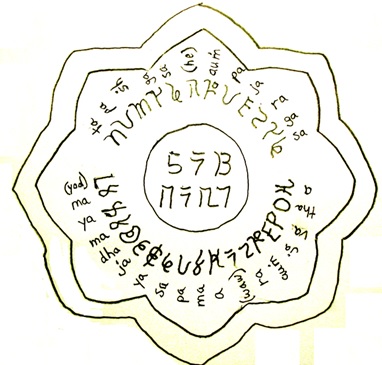
The seven central letters are from the Hebrew script used at the time of the Roman persecution of the Jews (the Roman siege against Jerusalem by Emperor Titus, 67-70c.e. and the destruction of the Jewish communities of Salamis, Cyprus and Leontopolis, Egypt early in the 2nd Century c.e.). The remaining letters appear to consistently match with the 2nd and 3rd Century c.e. Brahmi script in the regions of northwest India. These Brahmi letters run from the top right counterclockwise covering the first 12 letters and continuing around the bottom 18 letters. What is remarkable, is they also make sense read in reverse by intension to confirm the meaning of the text. These Brahmi words can be understood by an early Sanskrit dictionary. There meaning will unfold a definitive relationship between the mythology of Japan and India used to shed light on the situation of the 2nd Century c.e. Jewish diaspora.
The Brahmi and Hebrew Transcription
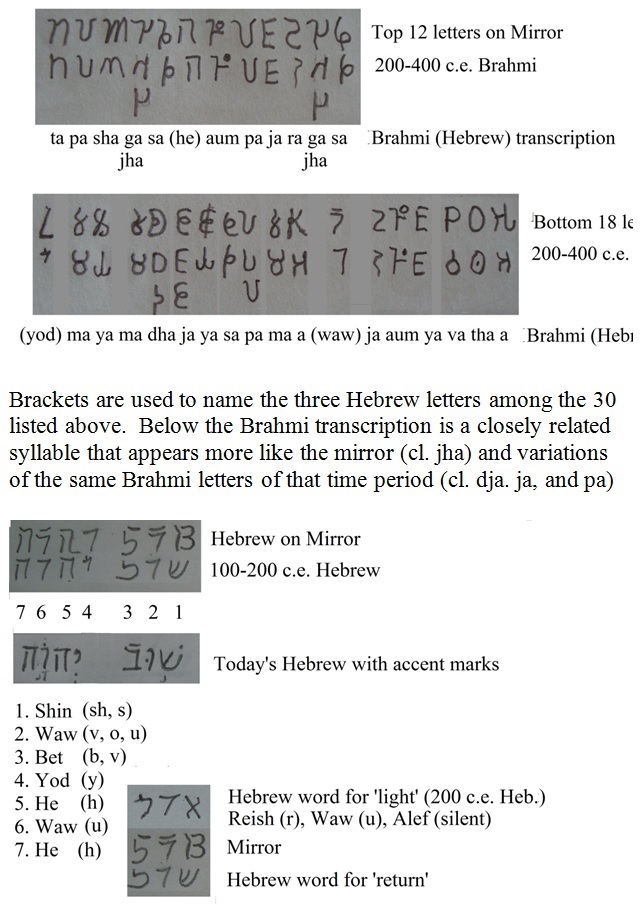
Five out of seven of the Hebrew letters have added marks on the letters of the mirror. Perhaps the authors attempted to hide the Hebrew somewhat so the mirror was not broken by those causing the exile. The extra lines may also be due to the author adding vowel and pronunciation marks as today’s Hebrew illustrates. In each case, today’s lines or dots are replaced by lines in the same portion of the word. Another possible word for the first three letters as noted by earlier researchers is the Hebrew word for light. ‘Light’ applies to the reflection on the mirror as the alternative choice of ‘return’ reflects the hope of return from exile by those who wrote on the mirror. Both words appear to match somewhat. Perhaps the author intended both to be understood as ‘turn to the light’ of God. The word God will be used in place of the actual Hebrew letters for Yahweh from this point on to respect the practice of keeping the word sacred.
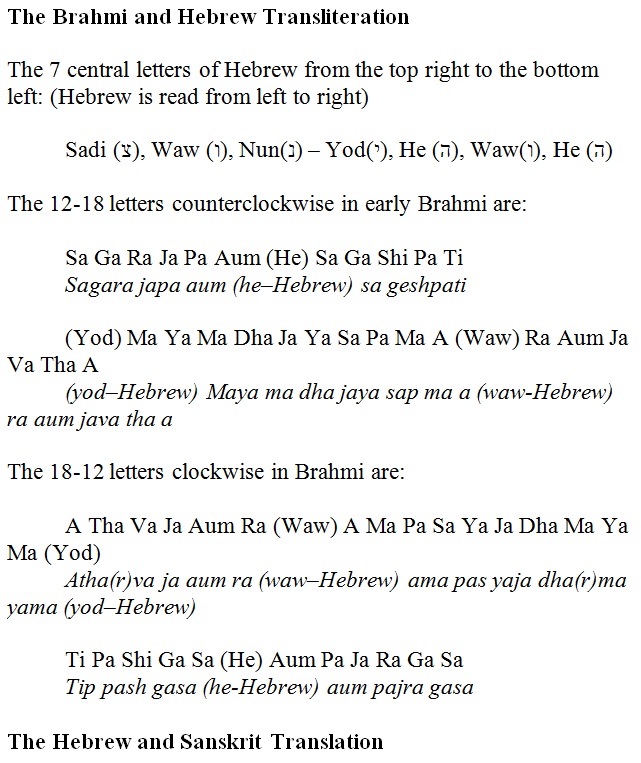
The three Hebrew letters hidden among the Brahmi script make Sanskrit vowel sounds, which add emphasis to the text. But taken by themselves, these three Hebrew letters make up their own Hebrew word also:
‘He’, ‘Waw’ and ‘Yod’ make up the Hebrew word for “Woe!; Ho!; Alas!; Come forth!”
As above the central portion reads (7 letters from Hebrew):
Return to God
Or
with the three hidden Hebrew letters:
Come forth! Return to God.
Or
Come forth! Light of God.
This is the call of Amaterasu. Also, these three letters are the three gifts Amaterasu gave to the Emperor of Japan. The original symbolic meaning of each Hebrew letter as it corresponds to the three sacred objects of the Shinto Shrine of Ise are:
‘yod’ – the symbol for a jewel or bead (from Amaterasu’s necklace)
‘waw’ - the symbol of a spear or sword (the sword from the defeated dragon, Yamata)
‘he’ - the symbol for jubilation or dance (performed with mirror beckoning Amaterasu out of the cave of darkness).
The counterclockwise Brahmi translation is:
Sagara japa aum (he-Hebrew) as Geshpati.
Sagara, King of the Solar Clan, pray softly the AUM; (Ah! Truly!) To reach towards Geshpati, the deity of invocations and speech.
(yod–Hebrew) Maya ma dha jayasa pam a (waw-Hebrew) ra aum java tha a
(Ee!) The horse’s cry causes victory and protection, take pity. (Oh!) With burning devotion AUM swift as a horse cry for our welfare, take pity.
The clockwise translation of the Brahmi is:
Atha(r)va ja aum ra (waw-Hebrew) ama pas yaja Dha(r)ma Yama (Yod-Hebrew)
Atharva, fire priest who writes sacred text, born from the AUM of brightness and glory; (Oh!) The soul beholds the sacrificial worship of the trumpet of Yama, deity of the underworld; (Come!)
Tip pash gasa (he-Hebrew) aum pajra gasa
Sprinkle the animal sacrifice together with the song. (Ah!) AUM the stout offering, (of the stout deity, Ganesa), and the song.
Choice of Brahmi and Hebrew letters:
The central Hebrew letters correspond with a blend of 3rd Century c.e. Hebrew and ancient Indian Brahmi (200-300 c.e. Kshatrapa or 300-500 c.e. Gupta). Within the outer region, the three Hebrew letters are obtained from the central decipherment.
Of the top 12 letters, ‘sa’, ‘ga’ and ‘pa’ occur twice and match exactly with the Brahmi. AUM is a near exact combination of the Brahmi ‘au’ and ‘m’. The ‘m’ sounds like ‘ng’ and is represented by the dot in the upper right portion of the aum glyph. The ja glyph is also an exact representation of the Brahmi. The Hebrew ‘he’ exactly matches the Hebrew letter. The two letters that appear questionable are the ‘ta’ and ‘sha’ appearing like the lowercase Roman numbers for ‘n’ and ‘m’. Changing the sound to ‘ti’ and ‘shi’ or ‘ish’ makes sense in terms of the appearance of Brahmi consonants with an ‘i’ appendage added. That is, the Brahmi script syllables vary based on the placement of the vowel around the fixed consonant, where ‘ta’ and ‘sha’ become near exact matches for ‘ti’ and ‘shi’ on the mirror.
Of the lower 18 symbols, 8 have been deciphered in the above 12 and are exact matches. However, the appearance of ‘ja’ changes, though both forms are acceptable in the early use of Brahmi. More exact Brahmi letters are the first ‘a’, ‘tha’, ‘ma’ and ‘dha’. Difficult to translate was the Brahmi ‘va’, the second ‘a’ and the two ‘ya’ letters. Perhaps a look at the mirror’s exact text is needed. However, these letters match well and only 7 of the 37 letters were not exact. That is a certainty of 80%. In the context of the diaspora Hebrews, an exact text may have exposed decipherment. The appearance of the ‘ya’ sign in Brahmi is a particular give away for the language. To hide this unusual letter the authors wrote the mirror’s ‘ya’ sign to be broken with the top appendage laid over the ‘ya’ to conceal it somewhat. It makes the Brahmi appear more Greek or Roman. Therefore, the authors hid the letters just enough to mystify the passerby, but not too much so the sound of the Trumpet of Yama might one day be heard.
Some important considerations:
The Hebrew letters divide the reading like a mirror. The Hebrew also begins and ends the writing.
The Three Hebrew letters in the Brahmi portion of the text taken by themselves as ‘He’, ‘Waw’ and ‘Yod’ make up the Hebrew word for “Woe!; Ho!; Alas!; Come forth!” When taken to mean ‘Come forth!’ the word occurs once in the Hebrew Bible in the following verse: Zechariah 2: 6 – “Ho! Ho! Flee from the land of the north, says the Lord; for I have spread you abroad as the four winds of the heavens, says the Lord. 7 – Ho! Escape to Zion, you who dwell with the daughter of Babylon.”
The sound of Aum comes from the Hebrew ‘Ayin’ and ‘Mem’ producing the word for ‘beside, before, juxtaposed’, like one standing across from a mirror. The word must have been also used by the early Hebrews who found refuge in nearby India during their exile. To prevent their numbers from overwhelming their hosts, the Hebrews must have spread out their clans across the East. Aum from the above Hebrew letters is found in the Hebrew Bible in Psalm 72, a song of Solomon pleading for a King of Justice and to enable the glory of God to fill the whole earth. The verse of this Aum has a peculiar saying. It literally reads: Psalm 72.5 – “May he (the king of justice) live with (aum) the sun and before the moon, through all generations!”
Choice of Sanskrit words:
The Mirror of Yata
Yata is also a Sanskrit word for ‘all people’, ‘to engage’ or ‘to control’.
There may be a play on this word as a lesson of wisdom for rulers to engage all people. Firstly, they are to Turn to the Light of God and the king is subject to Him.
The Bhagavad-gita 5.25 contains this word Yata as if to teach the meaning of a true ruler:
labhante
brahma-nirvanam
rsayah - ksina-kalmasah
chinna-dvaidha yatatmanah
sarva-bhuta-hite ratah
Synonyms
labhante — achieve;
brahma-nirvanam — liberation in the Supreme;
rsayah — those who are active within;
ksina-kalmasah — who are devoid of all sins;
chinna — having torn off;
dvaidhah — duality;
yata-atmanah — engaged in self-realization;
sarva-bhuta — for all living entities;
hite — in welfare work;
ratah — engaged.
Translation
To achieve true freedom in the Supreme be as those active (within the heart and mind), free from sin, having torn off duality, engaged in self-realization with all living things work for their welfare truly engaged.
Return to the light of God
The Prince and Priest of Japan (any nation or people) is being given the name of Yata in its full Sanskrit meaning so that when he looks in the Mirror of Yata all that he sees is the light of God, not himself.
Sagara japa aum A as Geshpati.
Sagara (King of the Solar Clan) pray softly the AUM; Truly! To reach towards Geshpati (the deity of invocations and speech).
The Leader of Peoples is given a second name:
Sagara
Sagara is the ancient Hindu King of the Solar Clan. Sagara attempts to prove his supremacy by a horse sacrifice. As well, Indra (the Supreme Being of the day who separated the earth from sky and dwelt in between) uses a horse to ride the sun as a chariot. This is why Indra stole the horse of Sagara and prevented the sacrifice. The 60 000 sons of Sagara dug a hole to capture the horse and found it beside the sage Kapila in deep meditation. They accused him of theft, but when he opened his eyes of innocence they all perished. The ancient message: all face eternal death in the hole of the underworld looking into the mirror of our soul trying to find our innocence.
Sagara’s decendents (grandson and great grandson) were used to retrieve the horse by being more polite to Kapila. Just like Amaterasu, it is the son who fails and the grandson who succeeds. The sage Kapila not only gave the horse back, but he also graciously imparted wisdom to enable all of Sagara’s sons to resurrect from the dead. The key was to convince the queen of living water, Ganges, to pour her river upon the earth. But this could only be done if the water was tempered and purified through the hair of Siva, creator deity of destruction and the moon. The proper homage was given to these deities and when so much as a drop of the river touched a bone of the dead, they were restored to life. The Shinto in Japan also practice misogi, the ritual cleansing of the body in the river near the shrine. The message: the Creator has provided the rivers of the earth, not merely to grow all living things, but also to serve as a symbol for the cleansing of the contrite human spirit.
japa
Japa is a form of prayer that is hummed or muttered using sacred incantations of the Hindu. The prayer is almost silent for only the still hearted to comprehend and to protect it from irreverent ears.
aum
The Hebrew use the sacred word of India. India was a safe haven for many Hebrews during the diaspora. The significance of this history was downplayed for colonial and political reasons and much of this story has yet to be rediscovered from the ancient past. In fact, this research is yet another clarification that there was more shared between ancient India and more local cultures, such as that of the Hebrews than the more distant Aryans. Therefore, this research warrants a deeper investigation on the topic of the use of Aryan propaganda to justify the colonial invasions. More important would be the open dialogue among scholars and the vital study regarding the genuine transfer of universal knowledge and spirituality between the cultures, in this case, between early India, the Middle East and the far East. And how these cultures grew up together like brothers and sisters under the care of a common yet diverse family of sages.
A (the Hebrew He)
This letter represents the number 5 and is the most sacred of the ancient Hebrew whose use of Kabala aided in the transmission of beliefs in times of persecution. The letter is a sacred talisman representing the hand and a silent way of expressing the sacred Name of God. Notice in India and other Indigenous art works containing the eye of enlightenment upon the hand. The symbol fits well here on the mirror for only the eye of the sacred to see. ‘He’ is also the symbol in Hebrew for thread (early Phoenician origins). The Hebrews were commanded to tie fringes (threads with five knots called tzitzit) to the corners of their garments. This is also a Shinto tradition; ie. shimenawa, the rope with hanging knots for priestly garments, used in marriage or to mark off sacred grounds. The most famous shimenawa is the Meoto Iwa, or husband and wife wedded stones representing Izanagi (the large) and Izanami (the small). These are the divine parents of Amaterasu.
(For Meoto Iwa see http://www.wayfaring.info/2009/06/10/rocks-that-rock/ )
For clarification on the Hebrew significance of this sacred fringe thread see Numbers 15:38 and Deuteronomy 22:12. In Hebrew, such a fringe also means a lock of hair, like that of which the angel grasped to lift up Ezekiel and carry him between heaven and earth (cl. Ez. 8:1-3). This raising of Ezekiel occurred before the captive priests of Israel. The angel that raised him appears like fire from the waist down and as a bright man from the waist up. The Hebrew presents a play on words between fire (esh) and man (ish). The letter ‘sh’ on the mirror contains the appendage possibly reflecting this play on words. There is a significant relationship between the remainder of Ezekiel 8 and the Hindu mythology of Sagara. Ezekiel 8 also expresses the digging of the hole through a temple wall; the finding of evil (lit. Lucifer) when exposed to light in the dark mirror; the purification of the self; the identification of the Creator of the sun (much like the Hindu Prajapati or Lord of Creation); the return to Jerusalem from the North (as in Zachariah 2: 6 above) and the purification of Jerusalem. The message in the mirror tells of a Hebrew people in exile who were not so much strict Zionists as they were Spiritual and they understood that Jerusalem was first in the heart. Though torn away from Jerusalem by their enemies, they were humble enough to look in the mirror and be the first to change. However, they also acknowledged that devotion to the One True God was the only way to be risen up by the hair of wisdom and purified by the sun’s enlightenment. This purification of the man, ‘ish’, is a purification by fire, ‘esh’, much like in the Shinto Shrine of Ise.
as Geshpati.
Embrace the deity of speech. The naming of another Hindu deity while using the name of God in Hebrew suggests three or more possibilities regarding the authors of the writing on this mirror. One possibility is the writers were Hebrews monotheists, and therefore wrote the name of another Hindu deity to mean not another god, but an attribute of the one true God that the human being looking in the mirror was responsible for embracing. Another possibility is the sages were blending there spiritual values on the mirror using syncretism or making a general religion out of two or more religions. A third possibility is that these sages belonged to two or more different spiritual backgrounds and were sharing their faith in a unified, yet distinct manner on the mirror. The message: embrace enlightenment through prayer, teachings and living by them with the appropriate actions and rites, while embracing all others of various spiritual backgrounds. In this regard the mirror offers an invaluable lesson to the world today torn apart by misunderstandings that often lead to suffering and war.
(yod–Hebrew) Maya ma dha jayasa pam a (waw-Hebrew) ra aum java tha a
(Ee!) The horse’s cry causes victory and protection, take pity. (Oh!) With burning devotion AUM swift as a horse cry for our welfare, take pity.
Maya ma
The horse of the Hindu and Japanese myths is perhaps the horse of time or season (ma). Ma also means poison. It was at the Churning of the Ocean the horse appears, but also the grey ocean soup, which was poison to humanity. Shiva swallows this poison to save the earth. Together with Yama, this underworld sacrifice appears to be represented in the Brahmi ‘ya’ glyph. The glyph is broken and pierced through (see transcription of ya above), as if the Hebrew/Brahmi authors intended to illustrate the sacrificial offering signified in the coded word.
dha jayasa pam a
To cause the victory together with protection. Pam may also be the word for drinking, as in drinking of the poison causes victory over death, the deity of the Underworld.
Ra aum java tha a
The burning fire of devotion, AUM, swift as a horse, this prayer for help. The Brahmi ‘a’ letters appear to be left hanging in the reverse, but in Sanskrit they can mean to take pity. It fits well in the mirror text.
Atha(r)va ja aum ra U ama pas yaja Dha(r)ma Yama I
Atharva (Fire deity or priest who writes sacred text) born from the AUM of brightness (heat, love, splendor); And more! The soul beholds the sacrifice (worship) of the trumpet (teachings) of Yama (deity of the underworld); Come!
Atha(r)va
In Sanskrit, the Atharvan’s are the priests of the fire altars and keepers or writers of the sacred word of god. Perhaps the Brahmi writing Atharvan welcomed the diaspora Hebrew priests into their circle of sages since in their own travels they faithfully kept their fires lit for travel and protected the Torah so faithfully.
ja aum ra
The Brahmi and Hebrew sages use another play on words with the name of the Egyptian sun god, Raa. But ‘ra’ is used as a modifier of the act of standing before God (aum – juxtaposed). The ‘ja’ means in Sanskrit, to be born by; born by the ‘aum’, the constant silent prayer we face when we turn to the true sun of justice, our own Creator by way of ‘ra’, burning devotion.
U (Waw)
The Hebrew ‘waw’ can be meant hear in two ways, as a joining together or an inverting. The meaning: on the mirror the soul is meant to invert from evil tendencies to good by joining to the light of God. The Hebrew letter also represents the number six, a symbol for death. Yet, Ezekiel 8 has the six persons (all the dead) that flank the angel much like the symbol of the menorah. All are called to be raise up like Ezekiel into enlightenment, purification, eternal life.
ama pas yaja
The soul beholds the sacrifice (the worship, the fire and offering). The words match the theme and present a contrast to the Atharvan fire priest. To be a true Atharvan, the soul must also go through the fire. Then the person looking through the fire may present anything at all and it will be a pure offering.
Dha(r)ma
Dhamma (Pali) and Dharma (Sanskrit) refers to the law, the teachings, and how to live by them. It may also mean to hold or a trumpet. Consider the holding of the trumpet as a first step to Dhamma, and then the blowing of the trumpet as a second step. However, one must practice and hold the sound itself in exactly the tune fit for the occasion. Such a skill requires a community, a mentor, a practice and a performance. This is the path of the apprentice on the spiritual journey to acquire a sense of belonging by developing a skill to honor God and the community by way of training, passage-rite and functional ceremony.
Yama
Yama is the Hindu deity of the Underworld, who has two guard dogs with four heads each. Notice in the Japanese myth of Amaterasu, Yamata is the eight-headed dragon killed, whose tail became a sword and sign of peace for Japan. And the Shinto shrines contain two koma-inu guard dogs facing each other. In Sanskrit, Yama means ‘raised’, like Ezekiel was raised by the angel by the hair into the sky. Yama may also mean a driver, a chariot or a twin, which relates the deity of the Underworld to Indra, the deity who drives the sun in a chariot. The twins as sun and moon, represent the twins within our own soul; the one who tends to evil and the one who tends to good. Venus as Morning and Evening Star is also represented as the twins of the Underworld. Venus is lost in the light of the sun for six days; on the seventh day, Venus is restored. The twin sister of Yama is Yami, the first born from the sun (vivasvat). The trumpet of Yama is used to herald the rising of the sun. The Dhamma of Yama is the teachings of enlightenment and the actions that prove the teachings are real. This ultimate reality is called in the Rig Veda, ‘rta’ (the Chinese ‘tao’, the Hebrew ‘torah’ or Christian ‘logos’):
O Indra, lead us on the path of Rta, on the right path over all evils. RV 10.133.6
Therefore, dhamma may also literally mean reality and the laws of the natural realm, but also creations way of living by those laws and maintaining harmony. Message: all travel the path of the sun, even through the underworld at death. Therefore taking a good look in the mirror with the eye of our Creator is necessary. Those invested in Dhamma are kind to all living things and they have a certain respect for the elements.
I (Yod)
The Hebrew ‘yod’ is the 10th letter and represents perfection. Message: ‘come’ to the mirror of creation and participate in perfection. It closes the message on the mirror and appears in its earliest pictoglyph form as an arm. Message: the arm of God holds the sun and moves us to enlightenment.
Tip pash gasa (he-Hebrew) aum pajra gasa
Sprinkle the animal sacrifice together with the song. (Ah!) AUM the stout offering, (of the stout deity, Ganesa), and the song.
Tip pash gasa
Sprinkle the animal sacrifice and sing. The Shinto shrine ceremonies include cleansing, offerings, prayers and dances to the ancestral kami.
Aum pajra gasa
AUM … the stout offering and the song.
Ganesa is the Hindu elephant head deity. He was a son of Shiva killed by decapitation and brought back to life with an elephant head. His elephant call can be likened here to the trumpet of Yama. His body is also very stout and so represents the stout offering mentioned here. The shape of Ganesa’s body is identified in India with the AUM symbol. He has a missing tusk he used to write with, which represents the justice and mercy of the god. Ganesa is the head of the ganas or followers of Shiva. The ganas were resurrected from death by the cleansing hair of Shiva, and Shiva’s celebration with drum and dance gave him the title, Lord of the Dance. In Japan, the kagura are the ancient ritual dances of the Shinto accompanied by musical instruments. In the sacred Hindu text, Chinmayananda’s upamantro 8, a prayer to Ganesa reflects the tone of the chant on the mirror:
O Lord Ganapati! You are the Trinity - Brahma, Vishnu, and Mahesa. You are Indra. You are fire [Agni] and air [Vayu]. You are the sun [Surya] and the moon [Chandrama]. You are Brahman. You are (the three worlds) Bhuloka [earth], Antariksha-loka [space], and Swargaloka [heaven]. You are Om. That is to say, You are all this.
The Chinese Mythology and Taoist Prayer
In Chinese myth there are ten suns each with their turn at day as their mother, Hsi Wang Mu (the Queen of the West/Tortoise) takes them across the sky in her sun chariot with six horse dragons. The horse(s) of her chariot is(are) sacrificed as they fall over the western horizon much like the horse of Sagara. She begins by a lake in the East at the tree of Yang-ku. Her children are washed in this lake every morning. To the West each sun arrives at the tree of Fu-Sang. The mythology is similar to that of Amaterasu when considering the tree placed outside the cave with the nine jewels and mirror hanging on its branches. In the Chinese myth, the sun rises through a hole in the base of the tree of the east. The Chinese yang sun is represented by the three-legged crow; the odd number three also stands for yang. There are ten such crows, much too hot and bright for life on earth. Therefore, the Archer Yi comes and shoots down nine of the ten crows leaving the one to continue providing light to the world.
The yin finds its home as the toad or hare of the moon. Heng-o or Chang-o, the wife of Archer Yi, is herself the moon goddess who offers the hare the wood of the cassia tree to pound the elixir of life. Heng-o will swallow the elixir and turn into a toad. Compared to the Japanese myth, Amaterasu might be reflected in the toad burrowed in the ground of the cave, while her reflection in the mirror is the moon, Heng-o, then jumping out of the cave at dawn as the Woman in the chariot of the sun, only to set as the Queen of the Western Paradise. The interaction between Chinese and Japanese myth lends well to the yin/yang philosophy of dual natures turning into each other and becoming one. Yet, the original nature of each remains in the whole producing a third harmonious binding force never separated from the virtue of loving kindness.
Tao gives life to the one
The one gives life to the two
The two gives life to the three
The three gives life to ten thousand things
All beings support yin and embrace yang
And the interplay of these two forces fills the universe
Yet only at the still-point,
Between the breathing in and the breathing out,
Can on capture these two in perfect harmony.
Tao Te Ching, Lao Tzu
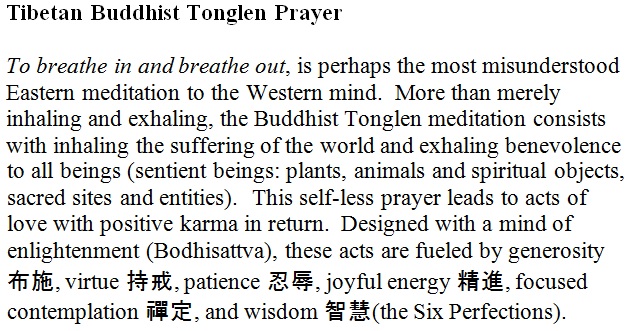
In Western experience consider the athlete before the championship match focused on the playing field and imagining his every move in the game ahead. No doubt in his meditation he scores point after point for his team. This is the act of the Bodhisattva in practicing the Tonglen; his team is every sentient being and his goal is to replace all suffering with acts of well-being. Those singing, laughing and dancing outside the cave of Amaterasu were intend on absorbing the suffering caused by Susanowa and releasing the goodness that Amaterasu had hidden in her cave; her light was not merely the sun, but enlightenment itself. We know it was enlightenment since even Susanowa turned toward her and repented.
The Buddha’s disciples asked their master before his last breath, ‘We beseech you, give us the sum of your teaching upon this last breath.’ The Buddha replied with his last breath, ‘I breathe in and I breathe out.’
Also see The Generation of an Altruistic Intention from the Tibetan Book of the Dead.
The Hindu Breathe to Imitate the Sun
Fire resolved, ‘I will burn’; the sun, ‘I will give heat’; the moon, ‘I will shine’; and so with the other deities, each according to its deity. Like the middle breath among the breaths is Vayu (deity of the Wind) among the deities. Other deities set, but not Vayu. Vayu is the deity who never goes down in the west.
There is a verse:
That from which the sun rises
And into which it sets…
It rises from breath (prana) and sets into breath.
… The gods made it dharma.
It is, today, and tomorrow, too.
What they resolved to do then they still do today. So one should undertake just one vow: one should breathe out and breathe in, thinking, ‘May not evil, may not death, hold me!’ And when one undertakes it, one should desire to bring it to completion. Then one wins union with that deity, shares a world win him (Vayu, equated with Breath). - Brhadaranyaka Upanisad 1.5
The prana are the 10 senses in Hindu philosophy, also called vital breaths. These prana are divided in two groups: the Jnanendriyas (knowledge senses), of hearing, touch, vision, taste and smell; and the Karmendriyas (action senses), of speech, grasping, walking, procreation and elimination. The Jnanedriyas are ‘breathed in’ and the Karmendriyas are ‘breathed out’. They reflect the 10 suns of the Chinese myth, where all sun must die in their setting in the west, but one is able to rise again. Of the 10 prana, the one that rises again is a form of procreation represented by various purifying passage rites including death itself and the final rebirth. The rising of Amaterasu out of her cave in the underworld is a reminder of these events of dying and rebirth intended to teach us how to actually rebound from suffering into life, joy, peace and enlightenment.
A Shinto Prayer
The following Shinto prayer, found in the Yengishiki, shows the Shintoists' intermingling of their spiritual feeling with nature and complements the prayer on the mirror:
I declare in the great presence of the From-Heaven-Shining-Great-Deity who sits in Ise.
Because the Sovereign great goddess bestows on him the countries of the four quarters over which her glance extends,
As far as the limit where Heaven stands up like a wall,
As far as the bounds where the country stands up distant,
As far as the limit where the blue clouds spread flat,
As far as the bounds where the white clouds lie away fallen-
The blue sea plain as far as the limit whither come the prows of the ships without drying poles or paddles,
The ships which continuously crowd on the great sea plain,
And the roads which men travel by land, as far as the limit whither come the horses' hoofs, with the baggage-cords tied tightly, treading the uneven rocks and tree-roots and standing up continuously in a long path without a break-
Making the narrow countries wide and the hilly countries plain,
And as it were drawing together the distant countries by throwing many tens of ropes over them
He will pile up the first-fruits like a range of hills in the great presence of the Sovereign great goddess, and will peacefully enjoy the remainder
Hebrew Breath and Resurrection
The Hebrew sages in exile in Japan shared their teachings with these Eastern sages involved in designing the inscription on the Mirror of Yata. The theme of breathing in life and resurrection of the 10th sun and Sagara’s 60000 coincide with the following Scripture from the Prophet Ezekiel:
The hand of the LORD was upon me, and the LORD carried me out in a spirit, and set me down in the midst of the valley, and it was full of bones; and He caused me to pass by them round about, and, behold, there were very many in the open valley; and, lo, they were very dry. And He said unto me: 'Son of man, can these bones live?'
And I answered: 'O Lord GOD, Thou knowest.'
Then He said unto me: 'Prophesy over these bones, and say unto them: O ye dry bones, hear the word of the LORD:
Thus saith the Lord GOD unto these bones:
Behold, I will cause breath to enter into you, and ye shall live.
And I will lay sinews upon you, and will bring up flesh upon you,
and cover you with skin, and put breath in you, and ye shall live;
that I am the LORD.'
So I prophesied as I was commanded;
and as I prophesied, there was a noise, and behold a commotion,
and the bones came together, bone to its bone. And I beheld, and, lo, there were
sinews upon them, and flesh came up, and skin covered them above; but there was no
breath in them.
Then said He unto me: 'Prophesy unto the breath, prophesy,
son of man, and say to the breath:
Thus saith the Lord GOD:
Come from the four winds,
O breath, and breathe upon these slain, that they may live.'
So I prophesied as He commanded me, and the breath came into them,
and they lived, and stood up upon their feet, an exceeding great host.
Then He said unto me: 'Son of man, these bones are the whole house of Israel;
behold, they say: Our bones are dried up, and our hope is lost; we are clean cut off. Therefore prophesy, and say unto them: Thus saith the Lord GOD:
Behold, I will open your graves, and cause you to come up out of your graves,
O My people; and I will bring you into the land of Israel. - Ezekiel 37:1-12
It is the prayer of the Rainbow Warrior looking for a reflection in the Mirror of Yata with even the faintest glimmer of light from the Creator: ‘Come from the four winds, O breath, and breathe upon these slain, that they may live.’ Breathing in the suffering of the world today brings about the awareness of the Global Warning crisis as the crossroads for humanity that it is. Breathing out the Rainbow Warrior Pledge to restore Mother Earth is the benevolent action that will unify humanity toward the return to that Promise Land spoken of by all our ancestors.
Consider the Hebrew myth of the Flood of Noah a parallel to the Chinese mythical hero Nu Kua (Nu Wa) who repaired the tilted earth with five stones of different colors (the five elements symbolized by the rainbow). From Adam to Noah there is an ancestral line of 10 Ancestors who are akin to the 10 sons of the ancient Chinese Queen of the West (Hsi Wang Mu). The 10 sons shone too brightly and lived too long, just as the line of 10 from Adam to Noah. One of the sons of Hsi Wang Mu was able to rise to enlighten the earth as the former 9 are struck down by the arrow of Yi, the Archer. Just the same, Noah has risen to offer humanity another opportunity towards enlightenment under the light of the sun.
Conclusion:
The writing on the back of the Mirror of Yata of Japan has been copied faithfully enough to decipher the ancient Brahmi from northern India with portions of Japanese, Chinese and Hebrew of the 2nd to 4th Century c.e.. Complementing contemporary theories regarding the origins of the Japanese scripts, this mirror’s symbols may be the earliest source of portions of the Katakana and Hiragana borrowed from the Chinese script. The evidence would suggest that Chinese sages where also present, together with the Indian and Hebrew sages who shared in designing this inscription with the Shinto priests at Ise, Japan. A critique of this research may brush it off out of a false sense of respect for this sacred icon of the Shinto religion. However, the research presents those who are devout with the opportunity to witness the opening of a Sacred Seal loaded with universal values to help bring those of all religions together for the first time just in time to restore the earth. The Buddhist in Tibet calls it a great and hidden gter-ma; the Hindu of India call it a nidhi; meaning ‘treasure’ and hidden by sages to be revealed in a future time when the world would have a desperate need. Today is the day, and the Mirror of Yata is the Treasure. Therefore, Japan, China and India received diaspora Jews from the early centuries of our era and there was an exchange of gifts and some sharing of culture and spirituality. The gifts included a mirror and with the mirror came the most sacred messages of the World Religions hidden in a cave of mystery one day to be revealed to unify humanity towards a new dawn of enlightenment.
Application: this research and its author are being maligned by the Police State in the measure exposed by the American hero and most true brother to us all, Edward Snowden. Be advised that in reading it you may also be harassed by the Police State or given false witness regarding the author by a malicious source. Contact the United Nations with the details of any such activity toward you. In spite of the assassination of his character in unspeakable manners and the symptoms of Major Clinical Depression reignited by this harassment from the Police State, the author is presenting the research anonymously as well as possible as a free gift to those of good will who will receive it and assist in the work of those Finding Turtle Island by the Rainbow Warrior Pledge to restore human harmony with Mother Earth. Those participating in this malicious activity listen to my outcry: I, whom Presidents and Queens have friended on Facebook, with bent knee and head bowed have received the 500th Elephant of the Hindu Sages, wild as it has appeared to you, is now tamely carrying me before you to convince you of the true way of Redemption of which all humanity is in need of in order to repent for causing global warming and restore our ecosystems. Take the Rainbow Warrior pledge in Finding Turtle Island lest you suffer the severe consequences caused by an inactive response to the 7th Fire Prophecy of the purification of the earth opened as a Great Seal on this Treasured Scroll and Mirror of Yata.
References
http://eos.kokugakuin.ac.jp/modules/xwords/entry.php?entryID=317
http://japanesereligions.blogspot.ca/2009/03/shimenawa-spelling-dilemma.html
http://www.isejingu.or.jp/english/myth/myth4.htm
http://upload.wikimedia.org/wikipedia/commons/2/26/Indus_Script_and_Brahmi_Script.gif
http://www.spi.com.sg/spi_files/shinto_shrine/secrets_of_shinto2.htm
http://en.wiktionary.org/wiki/Index:Chinese_radical
http://en.wikipedia.org/wiki/Man%27y%C5%8Dgana
http://e-macrobiotica.blogspot.ca/2011/01/yin-e-yang.html
http://en.wikipedia.org/wiki/Tonglen
http://www.mechon-mamre.org/p/pt/pt1237.htm
17-Aug-2013
More by : Anonymousfor JoshuaMessiah

|
Consider further Breathing In and Breathing Out meditations offered by Shiva's 112 Ways (1, 7, 15, 32... apply to the research above) http://o-meditation.com/2010/12/02/shivas-112-meditation-techniques/ |